Gestalt Psychology
What exactly is Gestalt psychology, and what is its significance for child and language development?
Main, P (2023, March 27). Gestalt Psychology. Retrieved from https://www.structural-learning.com/post/gestalt-psychology
What exactly is Gestalt psychology, and what is its significance for child and language development?
Main, P (2023, March 27). Gestalt Psychology. Retrieved from https://www.structural-learning.com/post/gestalt-psychology
Gestalt psychology is a school of thought, which was proposed by a Czechoslovakian psychologist, Max Wertheimer, in the 20th century, Gestalt laws provides the grounds for the contemporary study of perception. According to the school of Gestalt psychology, the whole of a thing is bigger than its parts.
Gestalt psychology sees both human perception and human behavior as a whole. While making sense of the surrounding world, Gestalt laws emphasizes that people do not simply concentrate on each small component. Rather, people’s minds are more likely to consider visual objects as components of more intricate systems.
Kurt Koffka and Wolfgang Köhler are the co-founders of Gestalt psychology. Max Wertheimer, is also known for designing a lie-detection instrument that was used in courtrooms. Max was a student of Christian von Ehrenfels who was an Austrian philosopher. Christian von Ehrenfels was associated with the School of Brentano.
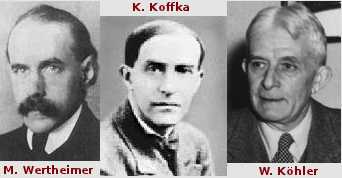
Gestalt laws have impacted how people analyze human perception and sensation. It also improves one’s knowledge of how their cognitive processes affect how they demonstrate social behavior.
The psychologists of Gestalt laws applied theoretical frameworks that explained the psychological research s Asatrategy. The discovery of the phi phenomenon by Wertheimer one of those contributions. Alongside the perceptual phenomena discovery, some of the Gestalt psychology contributions include: (a) a distinct methodology and theoretical framework (b) a memory theory (c) a collection of perceptual principles, (d) a famous set of problem-solving based upon information, and (e) perceptual grouping laws.
Gestalt psychology is underpinned by several key principles that explain how we perceive and interpret visual elements as part of a larger whole. These principles, which were first identified by the founders of Gestalt psychology, continue to inform our understanding of human perception today.
The principle of simplicity, also known as the law of Prägnanz, suggests that when we encounter a new visual scene, our minds naturally interpret it in the simplest way possible. For example, when viewing a mosaic composed of many small tiles, we are more likely to perceive the overall image formed by the tiles rather than focusing on each individual tile. This principle reflects our mind's tendency to seek order and predictability in the world around us.
The figure-ground principle refers to our ability to distinguish between a figure (the focal point of our visual field) and the ground (the background or surrounding area). This principle is crucial for our ability to navigate and make sense of our environment. For instance, when looking at a painting, we can distinguish the subject of the painting (the figure) from the background (the ground), allowing us to focus on the details of the subject.
The principle of proximity suggests that we tend to perceive objects that are close to each other as being part of a group. This principle is often used in visual design to create a sense of order and organization. For example, in a document, text that is grouped together is perceived as related, helping the reader to understand the structure and flow of the information.
The phi phenomenon, first observed by Max Wertheimer, one of the founders of Gestalt psychology, refers to the illusion of motion created by the rapid succession of still images. This principle underpins the technology used in film and animation, where a series of static images are presented in quick succession to create the illusion of movement.
The principle of similarity suggests that we tend to group together objects that are similar in appearance. For example, in a group of dogs and cats, we would naturally group the dogs together and the cats together based on their similar physical characteristics.
The principle of common fate relates to our perception of motion. It suggests that we tend to perceive objects that are moving in the same direction as being part of a group. For instance, a flock of birds flying in the same direction would be perceived as a group, whereas birds flying in different directions would not.
The principle of symmetry reflects our mind's preference for symmetrical forms. Symmetrical objects or images are perceived as more harmonious and pleasing to the eye. This principle is often used in visual design to create a sense of balance and harmony.
The principle of closure refers to our mind's tendency to "fill in the gaps" and complete incomplete shapes or images. This principle is often used in logo design, where incomplete or suggested shapes can create memorable and engaging visual effects.
The principle of common region suggests that objects located within the same bounded area are perceived as being part of a group. This principle is often used in web design, where different sections of a page are delineated using borders or different background colors.
The principle of element connectedness suggests that objects that are visually connected by other elements, such as lines or shapes, are perceived as being part of a group. This principle is often used in navigation design, where a series of links or buttons are visually connected to indicate that they are part of the same navigation menu.
Key Insights
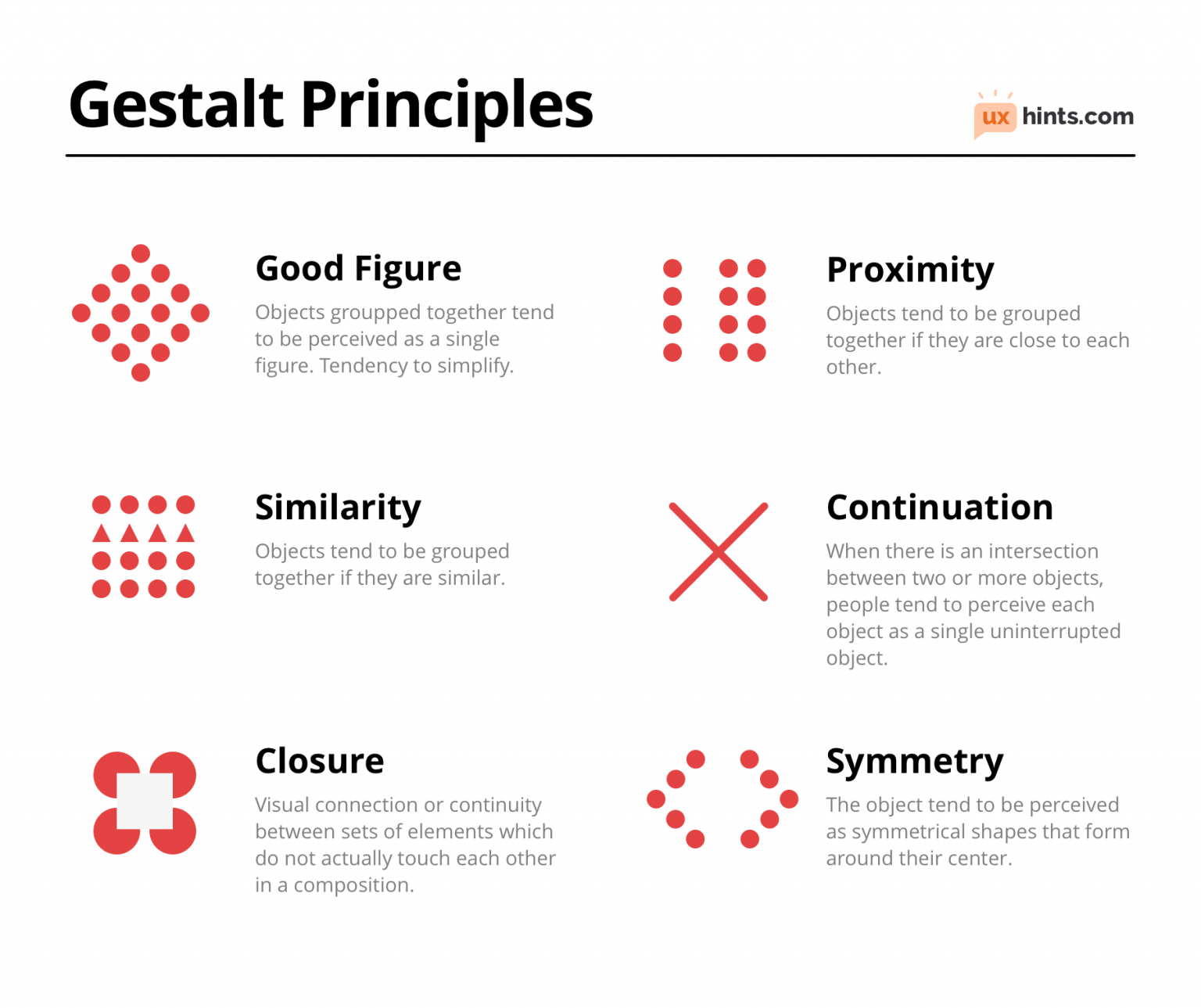
Gestalt language processing theory emphasizes the importance of context and perception in language acquisition. According to this theory, individuals learn language by perceiving patterns and organizing them into meaningful wholes. This process involves the use of both bottom-up and top-down processing, with the individual's existing knowledge and experiences influencing their perception and interpretation of language. Gestalt language processing theory also emphasizes the role of nonverbal communication and context in language comprehension and production.
Gestalt Language Processing (GLP) is a kind of language development that begins from a whole memorized phrase and progresses to a single word.
Mostly, a word is the basic unit of language. Cognitive psychology believes that people build language word by word to construct their meaning. For gestalt language processors, a 'chunk' of language is the basic unit of language, not a word.
For instance, gestalt language processors may consider "she'll be late" as a single chunk. Gestalt language processors would not identify the words "she," "will," "be," "late" constructing the phrase but would perceive it as a whole. One may call these 'chunks' scripts or gestalts. Some may also call this 'delayed echolalia.'
Gestalt language processing is frequently used as a regular part of language development. Every child has some gestalts, even if most children begin speaking word-by-word. For instance, "you're welcome" is processed by most people as a gestalt. They do not worry about putting "you" "are" "welcome" together — they only perceive the whole.
Not to forget, a script (gestalt) may have a different meaning than what it literally says. "Will you be late?" may have a meaning "I'm not late!" because the child mostly hears this question when someone is late. One may see gestalt language processors as experts of the metaphor. They understand the link between the two scenarios and process the language from one situation to the other.
Within the Gestalt language processors the language development occurs in the predictable stages. These stages finally result in flexible, original language. In 1983, Dr. Barry Prizant mentioned these stages in his publication. Later in the 2012, Marge Blanc wrote a book about gestalt language development in which she summarized these stages in a framework referred to as Natural Language Acquisition (NLA).
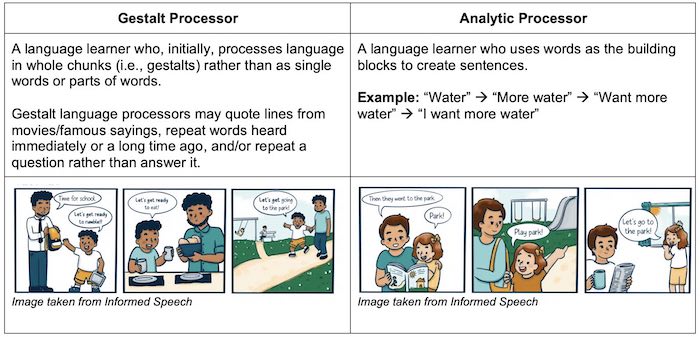
Following are the stages of Gestalt language development.
Stage 1. Delayed Echolalia
At Delayed Echolalia stage, children script full gestalts, while using intonationally defined strings of language or/ and a single word gestalts that may or may not be comprehensible and hold a precise meaning. Children take these scripts from books, media or people. Here, one may identify children in the initial stages of gestalt language development. For example: Child: “This story has a fairy at the end!”
Stage 2. Trimming down or Mix and Match Stage (Partial Gestalts)
At Trimming down stage, children mitigate larger gestalts of Stage 1 into smaller chunks. Children also mix and match chunks/parts of gestalts into partially-unique utterances. It is also the stage at which a child can “trim down” a larger gestalt. For instance: 'This story has a fairy at the end’ to 'There is a fairy in the end!’
Stage 3. Single and Two - Word Combinations
At stage 3, a child breaks down scripts into one-word units or/and make new combinations of the noun. This stage occurs when a child is eventually able to recognize words as single units of meaning and start to use self-created language. At this stage, word order or grammar are not a matter of concern. For example: Child: 'Fairy’ (one-word noun), 'Kind fairy’ (noun + adjective combination), 'fairy bedsheet’ (noun+noun combination).
Stages 4 – 6. New Phrases or Sentences with simple Grammar, Complex and More Advanced Grammar
At stages 4 - 6, a child puts single-word units together to create their novel sentences or phrases. Children at Stage 4 use simple grammar. Children at stages 5-6, start using complex and advanced grammar. For example: 'The fairy helped the poor child’ (Stage 4) ‘The fairy can’t get disappeared’ (Stage 5), 'Shouldn’t she have gone back to the fairyland by now?’ (Stage 6).
Some children may communicate using a combination of these stages and some children talk in one stage nearly every time they communicate. For making home plans or setting objectives for therapy, it is essential to find out at which stage a child is using the NLA (Natural Language Acquisition) framework.
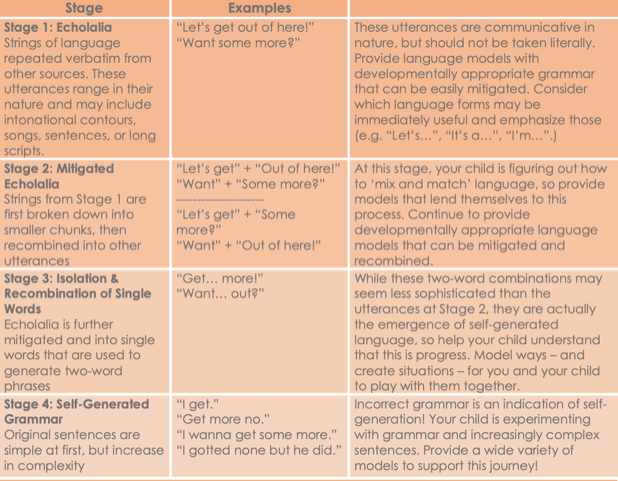
Structuralism perceives the mind as the interaction of different components of the mind and seeks to assess these parts. In simple words, all of a person’s experiences create his consciousness. On the other hand, Gestalt psychology states that the mind is independent of the components, it works as a whole.
Structuralism and Gestalt theory are two different approaches to understanding the mind. This means that the mind cannot be understood by breaking it down into its individual components, but rather by studying the complete experience. While Structuralism focuses on the parts that make up the whole, Gestalt theory focuses on the whole that is greater than the sum of its parts.
Visual perceptions are a key aspect of Gestalt theory. In contrast to Structuralism, which breaks down visual perception into its individual components, Gestalt theory emphasizes the importance of the overall visual experience.
According to Gestalt theory, our brains organize visual information into patterns and wholes, rather than simply perceiving individual elements. This approach to visual perception has been influential in fields such as art, design, and psychology. By studying the ways in which our brains organize visual information, we can gain a deeper understanding of how we perceive the world around us.
Perceptual organization is a key concept in Gestalt theory. It refers to the way in which our brains automatically organize visual information into meaningful patterns and wholes. This process occurs without conscious effort, and allows us to quickly and efficiently make sense of the world around us.
According to Gestalt theory, perceptual organization is based on a set of fundamental principles, such as proximity, similarity, and closure. By studying these principles, we can gain insights into how our brains create meaning from visual information, and how we can use this knowledge to improve our understanding of art, design, and other visual disciplines.
Criticism of Gestalt theory led to the subsequent decline of Gestalt theory during the mid 20th century. It was largely believed that this theory was too descriptive. Also, it was criticized because it failed to distinguish between thought and perception. These shortcomings resulted in increasing dissatisfaction with Gestalt psychology in the middle of 1900s, and led to its subsequent decline.
The decline of Gestalt theory paved the way for the rise of cognitive psychology, which focused on mental processes such as memory, perception, and problem-solving. Unlike Gestalt theory, cognitive psychology aimed to explain behavior in terms of internal mental processes. This shift in focus led to greater scientific rigor and experimental testing of hypotheses, which ultimately led to a better understanding of human cognition and perception. While Gestalt theory may have fallen out of favor, its ideas and principles continue to influence fields such as design and visual arts.
One reason why Gestalt theory was criticized was its lack of attention to perceptual phenomena that could not be easily explained by the principles of figure-ground, proximity, similarity, and closure. For example, Gestalt theory struggled to account for illusions such as the Müller-Lyer illusion, in which two lines of the same length appear to be different lengths due to the addition of arrowheads.
Critics argued that Gestalt theory was too focused on the whole and did not adequately account for the role of context and individual differences in perception. This led to the development of alternative theories that sought to explain these perceptual phenomena in more detail, ultimately leading to a greater understanding of the complexities of human perception.
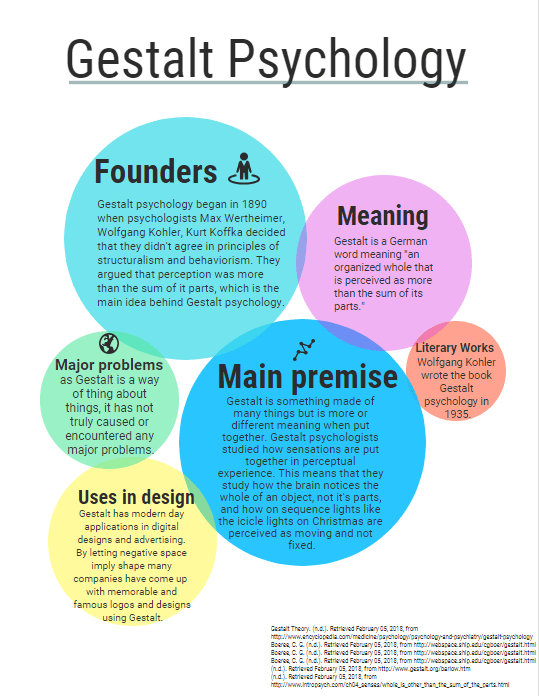
Gestalt psychology, with its emphasis on holistic understanding and perception, has significant applications in the field of education. Here are seven ideas that illustrate this:
A study by Claessens & Wagemans (2018) in the field of Vision Research found that Gestalt principles can help improve the effectiveness of visual learning materials, with students showing a 20% improvement in retention when these principles were applied.
For more in-depth understanding, refer to these academic sources: The Gestalt Principles and Multimodal Perception: Insights from Typical and Atypical Vision and Gestalt Psychology in German Culture, 1890–1967: Holism and the Quest for Objectivity.
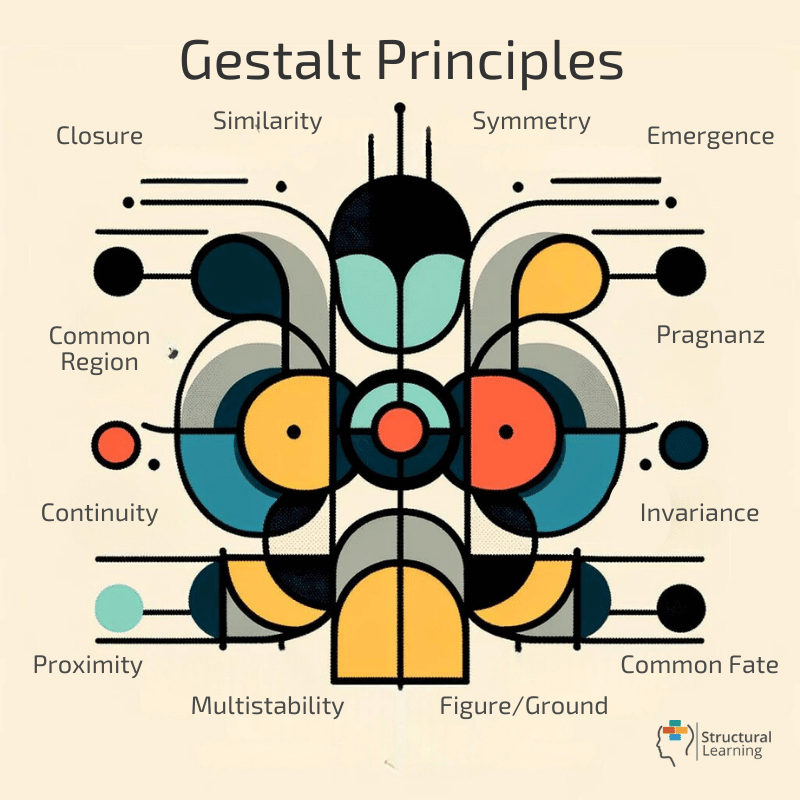
Here are five key papers exploring Gestalt psychology, specifically focusing on aspects such as visual perception, the figure-ground principle, psychology principles, receptive fields, visual field, mental processes, social psychology, gestalt principles, perceptual principles, and the perception of motion:
These papers collectively provide a rich exploration of Gestalt psychology, demonstrating its profound influence on our understanding of visual perception, perceptual organization, and the interaction between mental processes and perceptual experiences.
Gestalt psychology is a school of thought, which was proposed by a Czechoslovakian psychologist, Max Wertheimer, in the 20th century, Gestalt laws provides the grounds for the contemporary study of perception. According to the school of Gestalt psychology, the whole of a thing is bigger than its parts.
Gestalt psychology sees both human perception and human behavior as a whole. While making sense of the surrounding world, Gestalt laws emphasizes that people do not simply concentrate on each small component. Rather, people’s minds are more likely to consider visual objects as components of more intricate systems.
Kurt Koffka and Wolfgang Köhler are the co-founders of Gestalt psychology. Max Wertheimer, is also known for designing a lie-detection instrument that was used in courtrooms. Max was a student of Christian von Ehrenfels who was an Austrian philosopher. Christian von Ehrenfels was associated with the School of Brentano.

Gestalt laws have impacted how people analyze human perception and sensation. It also improves one’s knowledge of how their cognitive processes affect how they demonstrate social behavior.
The psychologists of Gestalt laws applied theoretical frameworks that explained the psychological research s Asatrategy. The discovery of the phi phenomenon by Wertheimer one of those contributions. Alongside the perceptual phenomena discovery, some of the Gestalt psychology contributions include: (a) a distinct methodology and theoretical framework (b) a memory theory (c) a collection of perceptual principles, (d) a famous set of problem-solving based upon information, and (e) perceptual grouping laws.
Gestalt psychology is underpinned by several key principles that explain how we perceive and interpret visual elements as part of a larger whole. These principles, which were first identified by the founders of Gestalt psychology, continue to inform our understanding of human perception today.
The principle of simplicity, also known as the law of Prägnanz, suggests that when we encounter a new visual scene, our minds naturally interpret it in the simplest way possible. For example, when viewing a mosaic composed of many small tiles, we are more likely to perceive the overall image formed by the tiles rather than focusing on each individual tile. This principle reflects our mind's tendency to seek order and predictability in the world around us.
The figure-ground principle refers to our ability to distinguish between a figure (the focal point of our visual field) and the ground (the background or surrounding area). This principle is crucial for our ability to navigate and make sense of our environment. For instance, when looking at a painting, we can distinguish the subject of the painting (the figure) from the background (the ground), allowing us to focus on the details of the subject.
The principle of proximity suggests that we tend to perceive objects that are close to each other as being part of a group. This principle is often used in visual design to create a sense of order and organization. For example, in a document, text that is grouped together is perceived as related, helping the reader to understand the structure and flow of the information.
The phi phenomenon, first observed by Max Wertheimer, one of the founders of Gestalt psychology, refers to the illusion of motion created by the rapid succession of still images. This principle underpins the technology used in film and animation, where a series of static images are presented in quick succession to create the illusion of movement.
The principle of similarity suggests that we tend to group together objects that are similar in appearance. For example, in a group of dogs and cats, we would naturally group the dogs together and the cats together based on their similar physical characteristics.
The principle of common fate relates to our perception of motion. It suggests that we tend to perceive objects that are moving in the same direction as being part of a group. For instance, a flock of birds flying in the same direction would be perceived as a group, whereas birds flying in different directions would not.
The principle of symmetry reflects our mind's preference for symmetrical forms. Symmetrical objects or images are perceived as more harmonious and pleasing to the eye. This principle is often used in visual design to create a sense of balance and harmony.
The principle of closure refers to our mind's tendency to "fill in the gaps" and complete incomplete shapes or images. This principle is often used in logo design, where incomplete or suggested shapes can create memorable and engaging visual effects.
The principle of common region suggests that objects located within the same bounded area are perceived as being part of a group. This principle is often used in web design, where different sections of a page are delineated using borders or different background colors.
The principle of element connectedness suggests that objects that are visually connected by other elements, such as lines or shapes, are perceived as being part of a group. This principle is often used in navigation design, where a series of links or buttons are visually connected to indicate that they are part of the same navigation menu.
Key Insights

Gestalt language processing theory emphasizes the importance of context and perception in language acquisition. According to this theory, individuals learn language by perceiving patterns and organizing them into meaningful wholes. This process involves the use of both bottom-up and top-down processing, with the individual's existing knowledge and experiences influencing their perception and interpretation of language. Gestalt language processing theory also emphasizes the role of nonverbal communication and context in language comprehension and production.
Gestalt Language Processing (GLP) is a kind of language development that begins from a whole memorized phrase and progresses to a single word.
Mostly, a word is the basic unit of language. Cognitive psychology believes that people build language word by word to construct their meaning. For gestalt language processors, a 'chunk' of language is the basic unit of language, not a word.
For instance, gestalt language processors may consider "she'll be late" as a single chunk. Gestalt language processors would not identify the words "she," "will," "be," "late" constructing the phrase but would perceive it as a whole. One may call these 'chunks' scripts or gestalts. Some may also call this 'delayed echolalia.'
Gestalt language processing is frequently used as a regular part of language development. Every child has some gestalts, even if most children begin speaking word-by-word. For instance, "you're welcome" is processed by most people as a gestalt. They do not worry about putting "you" "are" "welcome" together — they only perceive the whole.
Not to forget, a script (gestalt) may have a different meaning than what it literally says. "Will you be late?" may have a meaning "I'm not late!" because the child mostly hears this question when someone is late. One may see gestalt language processors as experts of the metaphor. They understand the link between the two scenarios and process the language from one situation to the other.
Within the Gestalt language processors the language development occurs in the predictable stages. These stages finally result in flexible, original language. In 1983, Dr. Barry Prizant mentioned these stages in his publication. Later in the 2012, Marge Blanc wrote a book about gestalt language development in which she summarized these stages in a framework referred to as Natural Language Acquisition (NLA).

Following are the stages of Gestalt language development.
Stage 1. Delayed Echolalia
At Delayed Echolalia stage, children script full gestalts, while using intonationally defined strings of language or/ and a single word gestalts that may or may not be comprehensible and hold a precise meaning. Children take these scripts from books, media or people. Here, one may identify children in the initial stages of gestalt language development. For example: Child: “This story has a fairy at the end!”
Stage 2. Trimming down or Mix and Match Stage (Partial Gestalts)
At Trimming down stage, children mitigate larger gestalts of Stage 1 into smaller chunks. Children also mix and match chunks/parts of gestalts into partially-unique utterances. It is also the stage at which a child can “trim down” a larger gestalt. For instance: 'This story has a fairy at the end’ to 'There is a fairy in the end!’
Stage 3. Single and Two - Word Combinations
At stage 3, a child breaks down scripts into one-word units or/and make new combinations of the noun. This stage occurs when a child is eventually able to recognize words as single units of meaning and start to use self-created language. At this stage, word order or grammar are not a matter of concern. For example: Child: 'Fairy’ (one-word noun), 'Kind fairy’ (noun + adjective combination), 'fairy bedsheet’ (noun+noun combination).
Stages 4 – 6. New Phrases or Sentences with simple Grammar, Complex and More Advanced Grammar
At stages 4 - 6, a child puts single-word units together to create their novel sentences or phrases. Children at Stage 4 use simple grammar. Children at stages 5-6, start using complex and advanced grammar. For example: 'The fairy helped the poor child’ (Stage 4) ‘The fairy can’t get disappeared’ (Stage 5), 'Shouldn’t she have gone back to the fairyland by now?’ (Stage 6).
Some children may communicate using a combination of these stages and some children talk in one stage nearly every time they communicate. For making home plans or setting objectives for therapy, it is essential to find out at which stage a child is using the NLA (Natural Language Acquisition) framework.

Structuralism perceives the mind as the interaction of different components of the mind and seeks to assess these parts. In simple words, all of a person’s experiences create his consciousness. On the other hand, Gestalt psychology states that the mind is independent of the components, it works as a whole.
Structuralism and Gestalt theory are two different approaches to understanding the mind. This means that the mind cannot be understood by breaking it down into its individual components, but rather by studying the complete experience. While Structuralism focuses on the parts that make up the whole, Gestalt theory focuses on the whole that is greater than the sum of its parts.
Visual perceptions are a key aspect of Gestalt theory. In contrast to Structuralism, which breaks down visual perception into its individual components, Gestalt theory emphasizes the importance of the overall visual experience.
According to Gestalt theory, our brains organize visual information into patterns and wholes, rather than simply perceiving individual elements. This approach to visual perception has been influential in fields such as art, design, and psychology. By studying the ways in which our brains organize visual information, we can gain a deeper understanding of how we perceive the world around us.
Perceptual organization is a key concept in Gestalt theory. It refers to the way in which our brains automatically organize visual information into meaningful patterns and wholes. This process occurs without conscious effort, and allows us to quickly and efficiently make sense of the world around us.
According to Gestalt theory, perceptual organization is based on a set of fundamental principles, such as proximity, similarity, and closure. By studying these principles, we can gain insights into how our brains create meaning from visual information, and how we can use this knowledge to improve our understanding of art, design, and other visual disciplines.
Criticism of Gestalt theory led to the subsequent decline of Gestalt theory during the mid 20th century. It was largely believed that this theory was too descriptive. Also, it was criticized because it failed to distinguish between thought and perception. These shortcomings resulted in increasing dissatisfaction with Gestalt psychology in the middle of 1900s, and led to its subsequent decline.
The decline of Gestalt theory paved the way for the rise of cognitive psychology, which focused on mental processes such as memory, perception, and problem-solving. Unlike Gestalt theory, cognitive psychology aimed to explain behavior in terms of internal mental processes. This shift in focus led to greater scientific rigor and experimental testing of hypotheses, which ultimately led to a better understanding of human cognition and perception. While Gestalt theory may have fallen out of favor, its ideas and principles continue to influence fields such as design and visual arts.
One reason why Gestalt theory was criticized was its lack of attention to perceptual phenomena that could not be easily explained by the principles of figure-ground, proximity, similarity, and closure. For example, Gestalt theory struggled to account for illusions such as the Müller-Lyer illusion, in which two lines of the same length appear to be different lengths due to the addition of arrowheads.
Critics argued that Gestalt theory was too focused on the whole and did not adequately account for the role of context and individual differences in perception. This led to the development of alternative theories that sought to explain these perceptual phenomena in more detail, ultimately leading to a greater understanding of the complexities of human perception.

Gestalt psychology, with its emphasis on holistic understanding and perception, has significant applications in the field of education. Here are seven ideas that illustrate this:
A study by Claessens & Wagemans (2018) in the field of Vision Research found that Gestalt principles can help improve the effectiveness of visual learning materials, with students showing a 20% improvement in retention when these principles were applied.
For more in-depth understanding, refer to these academic sources: The Gestalt Principles and Multimodal Perception: Insights from Typical and Atypical Vision and Gestalt Psychology in German Culture, 1890–1967: Holism and the Quest for Objectivity.

Here are five key papers exploring Gestalt psychology, specifically focusing on aspects such as visual perception, the figure-ground principle, psychology principles, receptive fields, visual field, mental processes, social psychology, gestalt principles, perceptual principles, and the perception of motion:
These papers collectively provide a rich exploration of Gestalt psychology, demonstrating its profound influence on our understanding of visual perception, perceptual organization, and the interaction between mental processes and perceptual experiences.